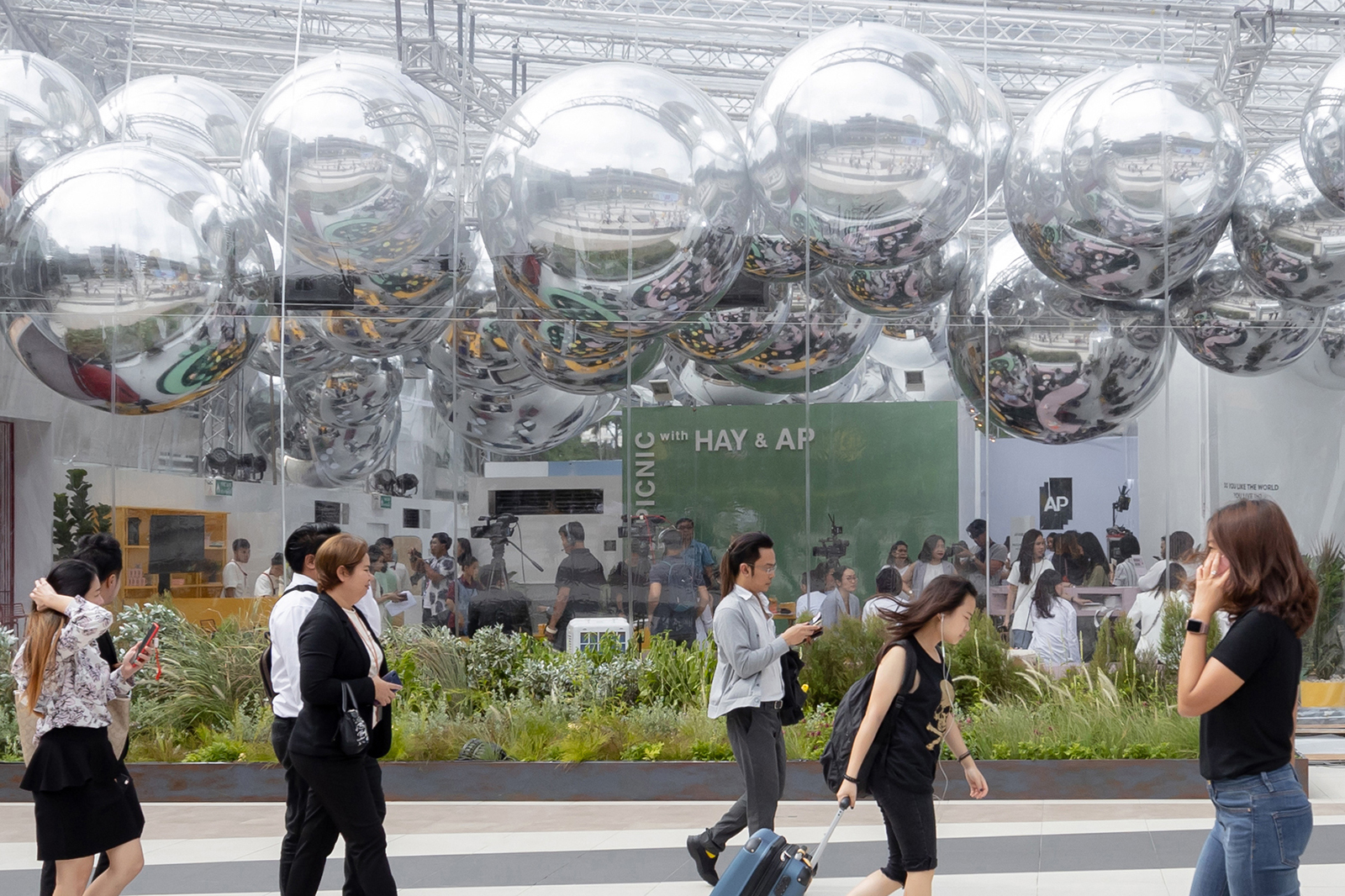TETSUO KONDO INTERPRETED A BASIC QUESTION – HOW ARCHITECTURE CAN CONNECT TO PEOPLE? – INTO A STRUCTURE THAT MERGES THE ORGANIZATIONS OF ATMOSPHERE AND PEOPLE TOGETHER
TEXT: KANOKWAN TRAKULYINGCHAROEN
PHOTO KETSIREE WONGWAN
(For English, please scroll down)
ใครที่ผ่านไปบริเวณลานกลางแจ้งของ Parc Paragon ระหว่าง 1-7 สิงหาคมที่ผ่านมา คงเอะใจอยู่ไม่น้อยว่า ใครเป็นคนทำพาวิลเลียนของ AP WORLD งานนี้เป็นผลงานออกแบบของ Tetsuo Kondo สถาปนิกชาวญี่ปุ่นที่เป็นที่รู้จักกันอย่างดีในวงกว้างจากผลงาน Cloudscapes ในงานเวนิสเบียนนาเล่สถาปัตยกรรมปี 2010 มาปีนี้ คนโดะและ Transsolar บริษัทที่ปรึกษาด้านเทคโนโลยีพลังงานในอาคารจากเมืองสตุทการ์ทมาพร้อมกับการตีความโจทย์ว่า “สถาปัตยกรรมจะเชื่อมโยงเข้าหาคนได้อย่างไร” ภายใต้สามแนวคิดการใช้ชีวิตที่เป็นฐานคิดหลักของ AP THAILAND อย่าง GROW การพัฒนาอย่างยั่งยืน, FLOW การสร้างสรรค์ประสบการณ์ในทุกมิติ, JOY ความสุขของการอยู่อาศัย ด้วยวิธีการที่แตกต่างออกไป
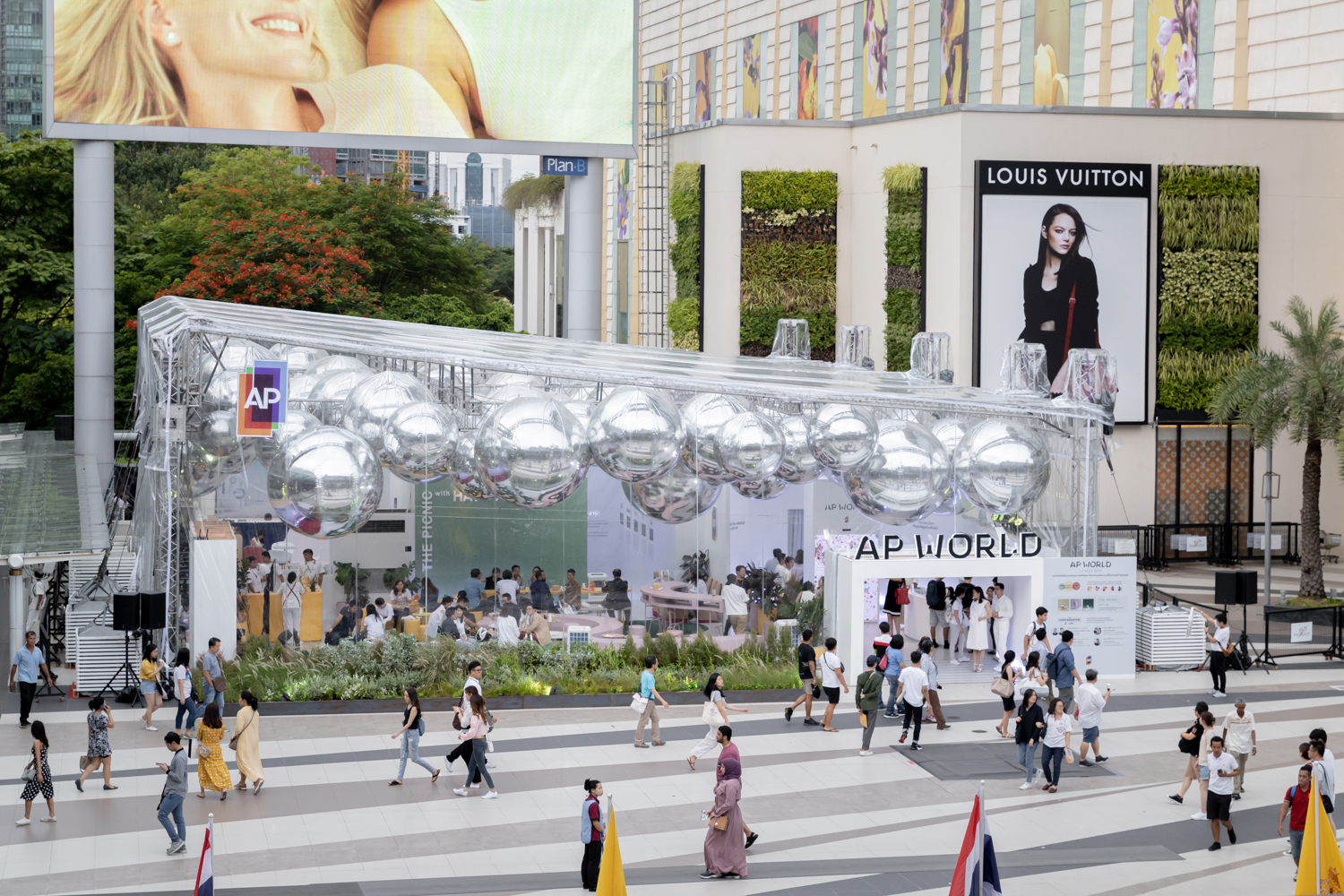
AP WORLD Pavilion at Parc Paragon, Bangkok
แน่นอนว่า งานออกแบบครั้งนี้ยังคงเล่นกับเลเยอร์ของอากาศ เพื่อนำเสนอมุมมองเรื่องที่ว่างในแบบฉบับของพวกเขาเหมือนเคย แต่สิ่งที่เปลี่ยนไปคือ วิธีการในการจัดการกับรูปแบบประสบการณ์ในที่ว่างที่ตั้งอยู่ใจกลางเมืองอย่างกรุงเทพ และการเลือกใช้รูปทรง สีสันและความหนาแน่นของลูกบอลอลูมิเนียมในงานออกแบบครั้งนี้
ในปี 2010 คนโดะและ Transsolar ได้ร่วมกันสร้างเมฆจริงๆ ขึ้นมาในอาคารจัดแสดงนิทรรศการ เพื่อเปิดให้คนที่เข้ามาชมได้เข้าไปสัมผัส “บรรยากาศ” ที่แยกตัวออกเป็นชั้นๆ ซึ่งมีสามชั้น คือ ใต้เมฆ ในเมฆ และบนเมฆ ในครั้งนั้น ใครหลายต่อหลายคนที่ได้ไปสัมผัสงานของพวกเขาอาจตั้งต้นด้วยการคิดไปว่า คนออกแบบตั้งใจให้มาดูเมฆ แต่เมื่อได้เข้าไปสัมผัสแล้ว ก็จะพบเองว่า สิ่งที่เขานำเสนอในงานชิ้นนั้นก็คือ การใช้เมฆชวนคนเข้าไปมีประสบการณ์กับที่ว่าง และเปิดมุมให้คนได้มองเห็นที่ว่างในแบบที่ต่างออกไป
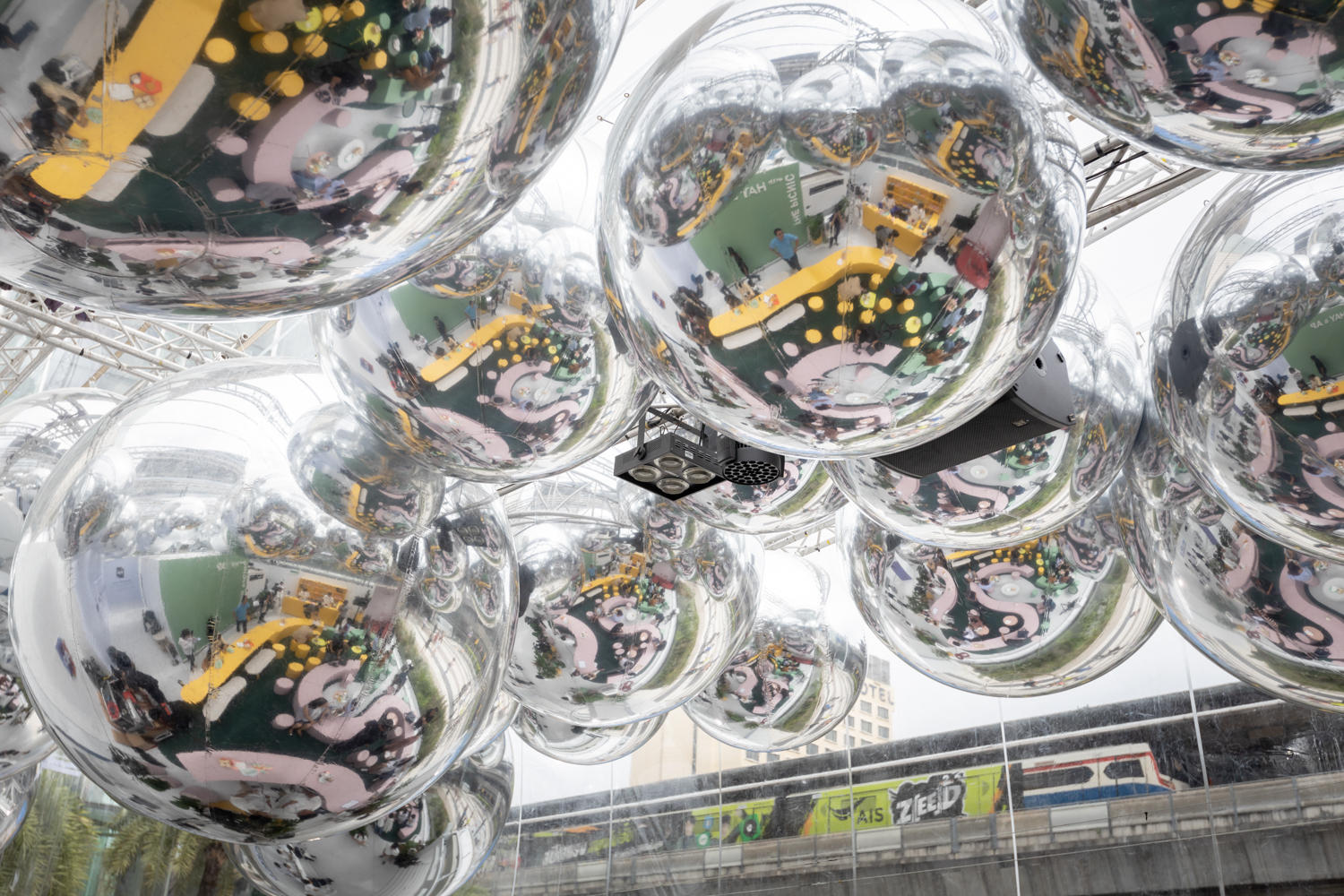
The layer of aluminium balls reflects both environment and solar radiation while creating a new form of playing with the concept of ceiling.
มาในครั้งนี้ คนโดะเลือกใช้โครงสร้างใสๆ ของพาวิลเลียนกับกลุ่มลูกบอลสีเงินขนาดใหญ่จำนวนมาก นอกจากจะให้มันทำงานคู่กันเพื่อนำสายตาและดึงความสนใจของผู้คนให้เข้ามาที่โถงทางเข้า ที่ประกอบด้วยส่วนปิกนิกที่จัดขึ้นร่วมกับ HAY และส่วนอินเตอร์แอคทีฟสเปซให้คนได้เล่นทาย DNA ในการใช้ชีวิตของเราซึ่งเป็นผลงานของ Eyedropper Fill แล้ว กองทัพลูกบอลสีเงินยังถือเป็นโซลูชั่นหลักในการจัดการบรรยากาศภายในพาวิลเลียนให้อยู่ในระดับร้อนพอรับได้ นั่งสนุก ลุกสบาย โดยการเข้ามาเป็นตัวกั้นแยกชั้นอากาศที่เป็นอุณหภูมิน่าสบายกับไอร้อนภายในอาคารออกจากกัน

ทีมออกแบบอาศัยคุณสมบัติเฉพาะของอลูมิเนียมที่สะท้อนรังสีของแดดได้ดี และเลือกรูปทรงกลมมาเป็นองค์ประกอบในการออกแบบ ซึ่งพลิกให้องค์ประกอบของฝ้าเพดานที่เรานิยมปกปิดเอาไว้ ให้กลับกลายเป็นชุดกลไกจัดการความร้อนที่น่ามองและตอบโจทย์หน้าที่ของเพดานไปพร้อมกัน เพราะลูกบอลเหล่านี้ทั้งคอยกันแดดและสร้างร่มเงาภายในพาวิเลียน ในขณะเดียวกันก็ช่วยกักไออากาศร้อนไว้ด้านบนก่อนที่จะถูกระบายออกไปด้วยเครื่องดูดอากาศ
คนโดะพูดไว้ได้อย่างน่าสนใจในกิจกรรมช่วง The Conversation ที่จัดขึ้นในบรรยากาศปิกนิกสบายๆ ช่วงบ่ายวันศุกร์ที่ผ่านมาว่า “ไม่ว่าคนจะเข้ามาที่พาวิลเลียนด้วยเหตุผลอะไรก็ตาม บางคนอาจจะเข้ามาและนั่งคิดหาเหตุผลว่า ทำไมมันถึงมีหน้าตาแบบนี้ บางคนก็อาจจะเข้ามาเพื่อมานั่งเล่น หรือนัดรอเจอเพื่อน ในขณะที่บางคนอาจตั้งใจเข้ามาดู AP WORLD หรือบางคนก็เข้ามาเพื่อถ่ายเซลฟี่กับเงาของพวกเขาบนลูกบอลที่ลอยอยู่ในอากาศ ไม่ว่าจะอย่างไรก็ดี ถ้าคนที่เข้ามาสามารถมีความสุขหรือสนุกไปกับพาวิลเลียนนี้ในแบบของพวกเขาได้ แค่นี้ผมก็มีความสุขแล้วครับ”
ติดตามอ่านบทสัมภาษณ์ฉบับเต็มถึงวิธีคิดและมุมมองในการทำงานของ เท็ตสึโอะ คนโดะ ได้ทาง art4d.com เร็วๆ นี้

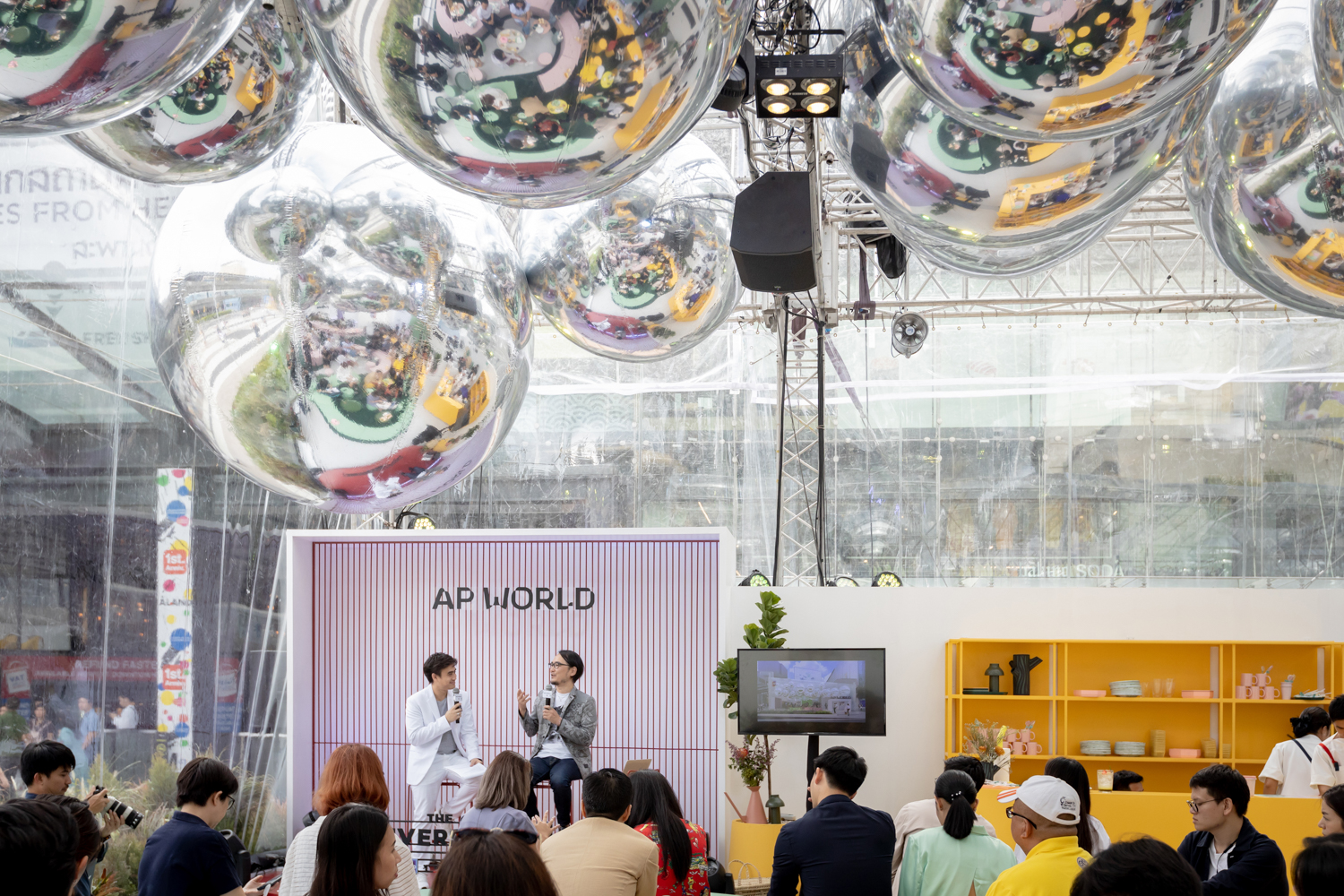
Passing through the transparent pavilion at Parc Paragon between 1-7 August, one may wonder about who made the Pavilion of AP WORLD? It is the work of the well-known Japanese architect Tetsuo Kondo, widely appreciated for his work “Cloudscapes” in the Venice Biennale Architecture 2010. This year, Kondo, in collaboration with Transsolar, a technical consulting company for energy efficiency and comfort in the built environment from Stuttgart, came with the same attitude but a slightly different method. The initial question was “how can architecture connect to people?” then he incorporated his interpretation into the design program together with the philosophy of living that are at the core of AP WORLD campaign: GROW for the sustainable future of living concept, FLOW for a community of share with seamless experiences supported by human-centered technological support, JOY for the better quality of living happily.
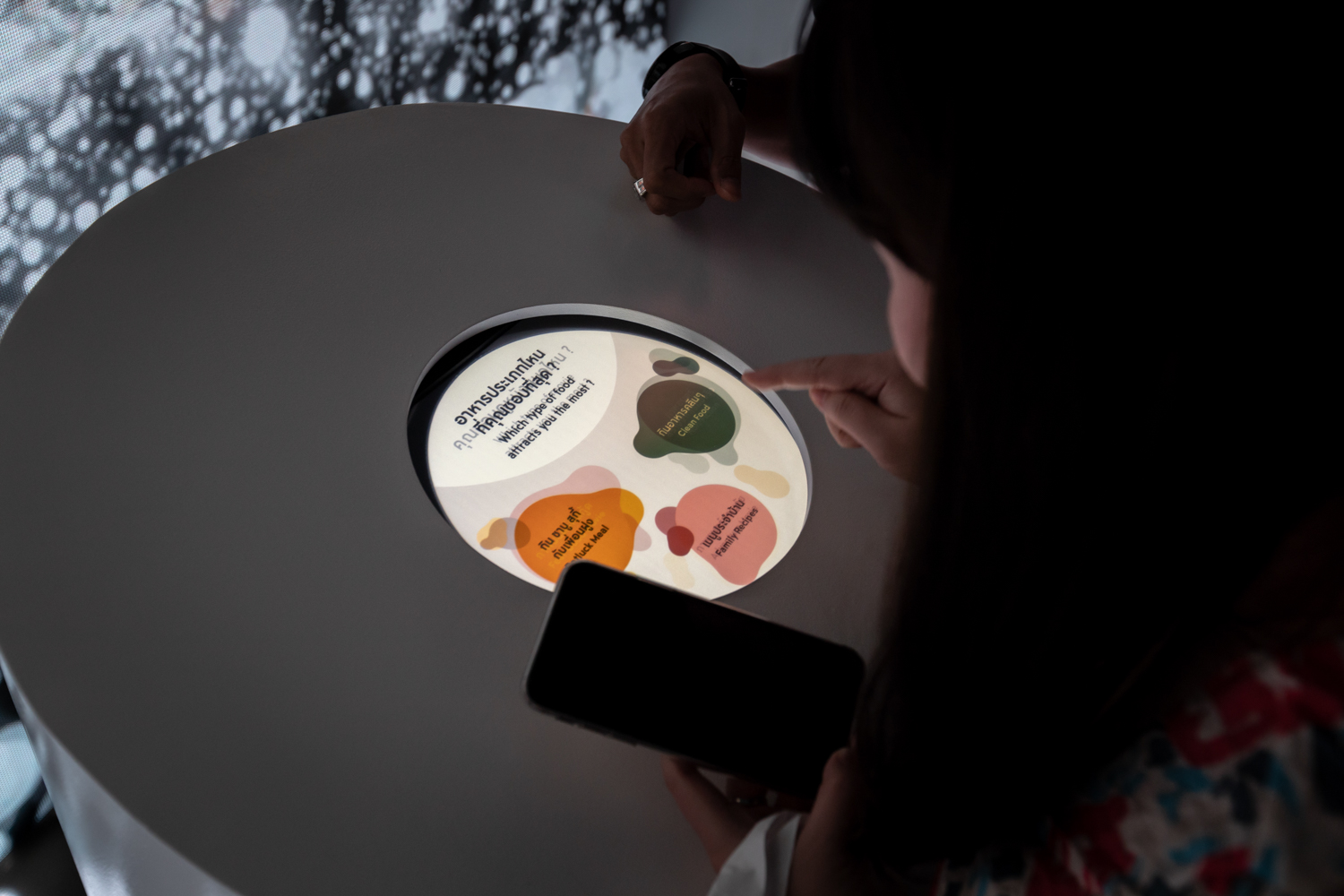
Of course, the designer still plays with the layers of air and turns it them in his way as usual. What has changed is the question “how to deal with the spatial experience in the city center like Bangkok” and the selection of shapes, color, and density of aluminum balls in the design.
In 2010, Kondo and Transsolar jointly created a real cloud in the exhibition building to allow people to come and experience the “atmosphere” that separates into three layers: beneath the clouds, in the clouds, and above the clouds. At that time, many people might begin to think that the designers intended to show the clouds floating in a hall. Later, people would find that the use of clouds is to invite people and let them experience the space differently.
This time, he chose a clear structure with a large number of silver balls and let two elements work together to catch passersby’s eyes. The entrance hall consists of a picnic area that is the collaboration with HAY and an interactive space for getting to know your lifestyle better, which is designed by Eyedropper Fill. The layers of silver balls serve as a solution for handling hot and cold air in the pavilion and a proper temperature that gives the feeling of hot and humid summer in Bangkok and allows people to enjoy the space.

The design team uses the unique properties of aluminum that reflect solar radiation and choose sphere form to be a design element. This solution flips the conventional idea of ceilings as a concealed part of the building structure into a transparent system for controlling the temperature inside the pavilion. It still keeps being pleasing to the eye, and interestingly performs the normal functions of the ceiling. The layers of these balls reflect solar radiation and create shade while it helps to keep the hot air always on top of the structure before ventilated by exhaust fans.
Kondo said during his afternoon talk session “the Conversation” in a picnic atmosphere last Friday: “some people may come to sit and think about the reason ‘why does it look like this?’, some may come to take a seat or wait for the time to meet friends, some may intend to watch AP WORLD and its projects, or some may make a visit to take a selfie shot with their reflection on balls floating in the air. No matter whatever reason may bring people to come into the pavilion, if the visitors can enjoy the spaces in their way, I’m happy already.”
Follow the full version of the exclusive interview with Tetsuo Kondo about his thoughts and his collaboration with Transsolar and AP Thailand soon on art4d.com

